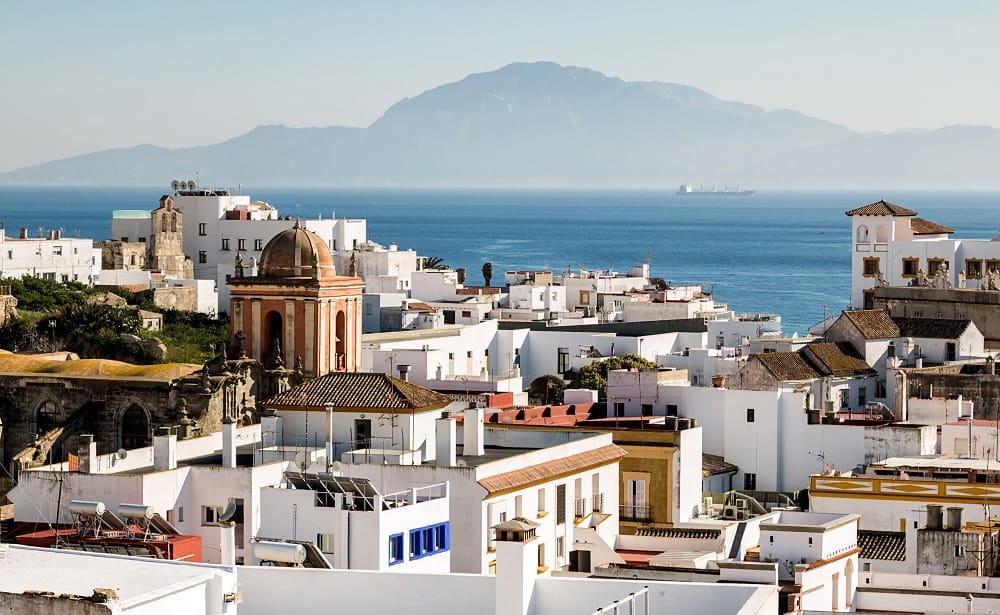In the heart of Andalusia, Cádiz stands as a testament to Spain’s rich tapestry of history, culture, and natural beauty. With its ancient streets echoing tales of bygone eras and its coastline offering a serene embrace of the Atlantic, Cádiz is more than just a city—it’s a journey. A journey that takes you through winding alleys, sun-kissed beaches, and moments frozen in time. As we delve into the wonders of this age-old city, let Carolina Fernandez, a native of Andalusia, be your guide through the mesmerizing world of Cádiz.
Table of Contents
- Historical Significance
- Looking to Learn Spanish? We’ve Got You Covered
- Cádiz Cathedral (Catedral de Cádiz): An Architectural Marvel of Andalusia
- Playa de la Caleta: A Coastal Gem of Cádiz
- Torre Tavira: A Window to Cádiz’s Maritime Legacy
- Mercado Central de Abastos: Cádiz’s Culinary Epicenter
- Castillo de Santa Catalina: Cádiz’s Coastal Bastion
- Explore the Old Town: Cádiz’s Historic Heartbeat
- Visit the Roman Theatre: Echoes of Ancient Cádiz
- Attend the Cádiz Carnival: A Celebration of Life, Music, and Tradition
- Take a Boat Tour: Navigating the Waters of Cádiz
- Sample Local Cuisine: A Culinary Journey Through Cádiz
- Cádiz Beyond the City: Discovering the Wider Province
Historical Significance
Cádiz’s historical tapestry is woven with threads from various civilizations, each leaving an indelible mark on its cultural and architectural landscape. Its origins trace back over 3,000 years, making it one of the most ancient cities in Western Europe.
The Phoenician Legacy
The Phoenicians, a seafaring people from the eastern Mediterranean, were the first to establish a settlement in Cádiz around 1100 BC. They named it ‘Gadir’ or ‘Agadir’, meaning ‘The Wall’, a testament to the fortified nature of the settlement. The remnants of the Phoenician era, including ancient walls and artifacts, can still be found in the city, bearing witness to its earliest inhabitants.
Roman Influence
Following the Phoenicians, the Romans made their mark on Cádiz. Under their rule, the city flourished as a significant port and trading hub. The Roman Theatre, one of the largest in the ancient world, stands as a testament to their architectural prowess and the city’s importance during this era.
Moorish Era and Reconquista
The Moors, who ruled the Iberian Peninsula for nearly eight centuries, brought with them Islamic architecture, art, and science. Their influence is evident in the city’s design, with its narrow winding streets and intricate architectural details. However, in 1262 AD, Cádiz was reclaimed by the Christian forces during the Reconquista, marking a new chapter in its history.
Age of Exploration
The Age of Exploration saw Cádiz rise to prominence once again. Its strategic location made it a pivotal port for voyages to the New World. The city played a crucial role in Spain’s maritime endeavors, with many expeditions, including those of Christopher Columbus, setting sail from its shores.
Modern Era
While Cádiz’s ancient history is undeniably rich, its more recent past is equally significant. The city played a pivotal role during the 1812 Spanish Constitution, earning it the title ‘La Tacita de Plata’ or ‘The Silver Teacup’. Today, while it embraces modernity, Cádiz remains deeply rooted in its past, ensuring that its historical legacy continues to thrive alongside contemporary advancements.
Looking to Learn Spanish? We’ve Got You Covered
The Best Intensive Spanish Classes in the World’s Top Cities


Buenos Aires: Great City, Great Classes.


Malaga: Where Study Meets the Beach.
Embark on Your Spanish Classes Today: Click Here


Your Own City: Online Classes.
Embark on Your Online Spanish Classes: Click Here
Cádiz Cathedral (Catedral de Cádiz): An Architectural Marvel of Andalusia
The Cádiz Cathedral, often referred to as the Cathedral of Santa Cruz, stands as a beacon of architectural grandeur and historical significance in the heart of Cádiz. With its towering spires, intricate facades, and the iconic golden dome, this cathedral is not just a place of worship but also a testament to the city’s rich cultural and artistic heritage.
Historical Background
Construction of the Cádiz Cathedral began in 1722 and spanned over a century, culminating in 1838. This extended construction period led to a blend of architectural styles, with Baroque, Rococo, and Neoclassical elements seamlessly integrated into its design. The cathedral was built on the site of an older church that was destroyed by fire, and its construction was financed through trade with the Spanish colonies in the Americas.
Also read about: Sevilla’s Cathedral: A Masterpiece of Gothic Architecture
Architectural Highlights
The cathedral’s facade is a harmonious blend of white and golden-yellow stones, adorned with statues of saints and intricate carvings. The main entrance, the Puerta del Perdón, is flanked by two imposing towers. However, the most striking feature is undoubtedly its golden dome, which glistens under the Andalusian sun and can be seen from various vantage points across the cit
Inside, the cathedral boasts a vast nave, side chapels, and an impressive choir area. The altarpiece, made of mahogany and cedar, is a masterpiece of religious art, depicting scenes from the life of Christ. The cathedral’s treasury houses a collection of religious artifacts, including paintings, sculptures, and relics, some of which date back to the 16th century.
The Poniente Tower
For those seeking panoramic views of Cádiz and the surrounding coastline, a climb up the Poniente Tower is a must. The tower offers a 360-degree view, providing a unique perspective of the city’s layout, the bustling port, and the vast expanse of the Atlantic Ocean.
Interested in Learning More About Cathedrals?: Malaga’s Cathedral: All you Need to Know About “La Manquita”
Practical Information for Visitors
- Opening Hours: The cathedral is open to visitors from Monday to Saturday, from 10:00 AM to 7:00 PM. On Sundays, it’s open from 1:30 PM to 4:30 PM. However, these timings may vary on religious holidays and special occasions.
- Tickets: There’s an entrance fee, which includes access to the cathedral, its towers, and the adjoining Cathedral Museum. Discounts are available for students, seniors, and large groups. It’s advisable to purchase tickets in advance, especially during peak tourist seasons.
- Guided Tours: For a deeper understanding of the cathedral’s history, architecture, and religious significance, consider joining a guided tour. These tours, led by knowledgeable guides, offer insights into the cathedral’s hidden gems and lesser-known facts.
- Dress Code: As a place of worship, visitors are expected to dress modestly. It’s recommended to wear clothing that covers the shoulders and knees.


Playa de la Caleta: A Coastal Gem of Cádiz
Nestled between two emblematic fortresses, Castillo de San Sebastián and Castillo de Santa Catalina, Playa de la Caleta is more than just a beach; it’s a symbol of Cádiz’s rich history and natural beauty. This urban beach, with its golden sands and gentle Atlantic waves, has been a source of inspiration for poets, musicians, and artists for centuries.
Location and Accessibility
Situated in the heart of Cádiz’s historic center, Playa de la Caleta is easily accessible by foot, making it a favorite spot for both locals and tourists. Its central location means that it’s well-connected by the city’s public transportation system, with several bus stops nearby. For those driving, there are parking facilities in the vicinity, though they tend to fill up quickly during the summer months.
Natural Beauty and Atmosphere
The beach’s crescent shape, combined with the backdrop of the two ancient fortresses, creates a picturesque setting that’s perfect for relaxation and recreation. The gentle slope of the seabed makes it ideal for swimming, even for young children. As the day progresses, the beach transforms into a vibrant hub of activity, with locals playing beach volleyball, families building sandcastles, and couples enjoying leisurely strolls along the promenad
Also read about: The Most Beautiful Beaches in Málaga
Amenities and Services
Playa de la Caleta is well-equipped with amenities to ensure a comfortable beach experience. Sunbeds and umbrellas are available for rent, and there are several beach bars (chiringuitos) where you can savor local delicacies and refreshing drinks. Clean restrooms, showers, and changing facilities are strategically located along the beach. For those with mobility challenges, the beach offers accessible walkways and adapted sunbed
Cultural Significance
The beach has been a muse for many artistic creations, including the famous Spanish song “La Caleta.” Its cultural significance is further highlighted during the annual Cádiz Carnival, where the beach becomes a focal point for celebrations, performances, and traditional dance
Tips for Visitors
- The beach can get crowded, especially during the summer months and weekends. Arriving early ensures a prime spot on the sand.
- While the beach is free to access, renting sunbeds and umbrellas comes with a fee. It’s advisable to bring some cash.
- The promenade is lined with restaurants and cafes, offering a range of dining options. Don’t miss the opportunity to try the local seafood, especially the fried fish.
- Sunsets at Playa de la Caleta are particularly mesmerizing. Stay until the evening to witness the sun setting over the Atlantic, casting a golden hue over the beach and turning the sky into a canvas of vibrant colors.
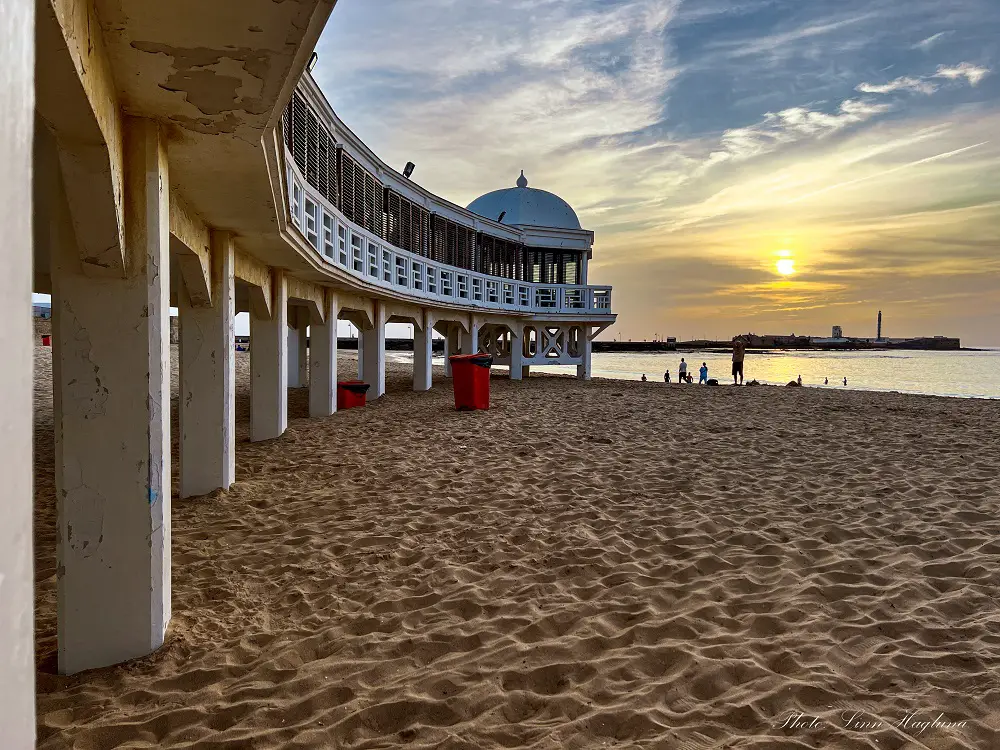

Torre Tavira: A Window to Cádiz’s Maritime Legacy
Perched in the heart of Cádiz’s historic district, the Torre Tavira stands as a silent sentinel, bearing witness to the city’s maritime legacy and its evolution over the centuries. More than just a watchtower, it offers a unique blend of history, technology, and panoramic vistas, making it an essential stop for anyone visiting Cádiz.
Historical Significance
In the 18th century, Cádiz was a bustling port city, with ships arriving from the Americas laden with goods. To monitor this maritime traffic, the city had over 160 watchtowers. Of these, Torre Tavira was designated the official watchtower, primarily because of its strategic location as the highest point in the old town. Named after its first watchman, Antonio Tavira, the tower played a crucial role in the city’s trade and commerce.
Architectural Splendor
The tower’s design is a testament to Andalusian architecture. Its whitewashed exterior, crowned with a terracotta-tiled roof, exudes a rustic charm. A series of arched windows punctuate the tower, allowing for natural light and ventilation. The internal spiral staircase, leading to the top, offers glimpses of the tower’s robust construction.
The Cámara Oscura
One of the tower’s standout features is the “Cámara Oscura,” a darkened room equipped with an optical device. This apparatus, consisting of a convex lens and a mirror, projects live images of Cádiz onto a concave screen. It’s a mesmerizing experience, offering a 360-degree bird’s-eye view of the city in real-time. The play of light and shadows, combined with the moving images of people, vehicles, and waves, creates a magical, almost cinematic experience
Visitor Information
- Opening Hours: Torre Tavira is open to the public daily from 10:00 AM to 6:00 PM. However, these timings may vary based on the season and special events.
- Tickets: There’s an entrance fee, which includes access to the tower and a guided demonstration of the Cámara Oscura. Discounts are available for children, seniors, and groups.
- Location and Accessibility: Situated on Calle Marqués del Real Tesoro, the tower is easily accessible by foot from most parts of the old town. Given its central location, there are several cafes, restaurants, and shops nearby, making it convenient for visitors.
- Guided Tours: While the Cámara Oscura demonstration is usually guided, visitors can also opt for comprehensive guided tours that delve into the tower’s history, architecture, and its significance in Cádiz’s maritime activities.
Tips for a Memorable Visit
- The top of the tower can get crowded, especially during peak tourist hours. It’s advisable to visit early in the morning or late afternoon for a more serene experience.
- The Cámara Oscura demonstration is conducted at regular intervals. It’s recommended to check the schedule upon arrival to avoid long waiting times.
- Don’t forget to carry a camera! The panoramic views from the tower’s terrace are breathtaking and offer excellent photo opportunities.


Mercado Central de Abastos: Cádiz’s Culinary Epicenter
In the heart of Cádiz lies the Mercado Central de Abastos, a bustling marketplace that serves as the city’s culinary epicenter. With its vibrant atmosphere, diverse offerings, and rich history, the market is more than just a shopping destination; it’s a sensory experience that captures the essence of Cádiz’s gastronomic culture.
Historical Roots
Established in the early 19th century, the Mercado Central de Abastos has been the go-to place for fresh produce for generations of Cádiz residents. The market’s architecture reflects its age, with a blend of neoclassical and modernist styles. Over the years, while the structure has undergone renovations, it has retained its historical charm, making it a blend of the old and the n
A Gastronomic Haven
With over 150 stalls, the market offers a vast array of products. From the freshest seafood, caught in the nearby Atlantic waters, to locally grown fruits and vegetables, the offerings are a testament to the region’s rich biodiversity. Butchers showcase prime cuts of meat, while artisanal vendors offer cheeses, olives, and other delicacies. The aroma of freshly baked bread wafts from bakeries, and wine stalls display bottles from local vineyards.
Don’t forget to try: Turrones de España: A Journey through the Best Turrones in Andalucía
Culinary Experiences
Beyond shopping, the market offers a range of culinary experiences. Several stalls serve cooked meals, allowing visitors to sample traditional Andalusian dishes. Whether it’s the famed “pescaíto frito” (fried fish) or a plate of “jamón ibérico” (Iberian ham), the flavors are authentic and delectable. Pair your meal with a glass of “fino” or “manzanilla,” local sherry varieties, for a complete gastronomic delight.
Visitor Information:
- Opening Hours: The market operates from 9:00 AM to 3:00 PM, with the busiest hours being in the morning. It’s advisable to visit early to witness the market in full swing and to get the freshest produce.
- Location: Situated in the Plaza Libertad, the market’s central location makes it easily accessible from various parts of the city. The surrounding area is dotted with cafes and restaurants, making it a lively hub throughout the day.
- Payment: While some vendors accept credit cards, many prefer cash. It’s a good idea to carry some change, especially if you’re looking to buy small quantities.
Tips for a Fulfilling Visit:
- Engage with the vendors. Many of them have been running their stalls for generations and have a wealth of knowledge about their products. They’re often more than happy to share stories, recipes, and cooking tips.
- If you’re unfamiliar with a product, don’t hesitate to ask for a sample. Many vendors offer tastings, especially for cheeses, olives, and wines.
- Consider taking a guided tour. Several companies offer market tours, providing insights into its history, the various products, and even cooking demonstrations.
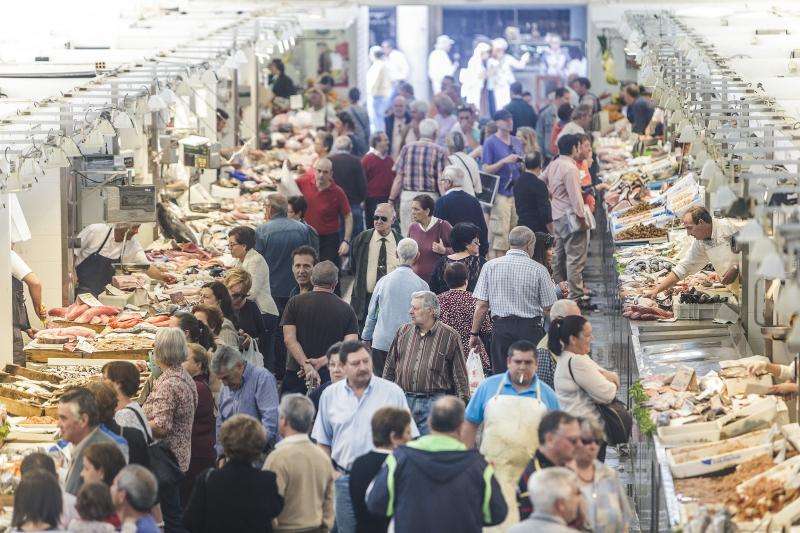

Castillo de Santa Catalina: Cádiz’s Coastal Bastion
Perched on the edge of La Caleta beach, the Castillo de Santa Catalina stands as a majestic reminder of Cádiz’s strategic importance and its storied past. This star-shaped fortress, with its imposing walls and panoramic sea views, is not just an architectural marvel but also a symbol of the city’s resilience and historical significance.
Historical Overview
Constructed in the late 16th century, the Castillo de Santa Catalina was commissioned by King Philip II in response to the English raid on Cádiz in 1596. Designed by the engineer Cristóbal de Rojas, the fortress served as a defensive stronghold, protecting the city from potential invasions and pirate attacks. Its star-shaped design was cutting-edge for its time, providing optimal defense capabilities and a wide field of vision.
Architectural Highlights
The fortress’s design is a blend of Renaissance and military architectural styles. Its thick walls, punctuated by sentry boxes and battlements, have withstood the test of time. The central courtyard, surrounded by barracks and storerooms, served as the heart of the fortress. The chapel, dedicated to Santa Catalina of Alexandria, showcases beautiful religious art and is a serene space for reflection.
Modern-Day Significance
While the Castillo de Santa Catalina once played a pivotal role in Cádiz’s defense, it has now been repurposed as a cultural and exhibition center. The rooms that once housed soldiers and stored ammunition now host art exhibitions, workshops, and cultural events. The fortress’s unique architecture and historical ambiance make it a sought-after venue for various events.
Visitor Information
- Opening Hours: The Castillo de Santa Catalina is open to the public from 10:00 AM to 7:00 PM. However, these timings may vary based on exhibitions and special events.
- Tickets: Entrance to the fortress is free. However, some exhibitions or events might have a separate fee.
- Location: Located on the La Caleta beach, the fortress is easily accessible by foot from the city center. Its proximity to the beach also makes it a popular spot for visitors looking to combine history with leisure.
- Guided Tours: For a deeper understanding of the fortress’s history and architecture, consider joining a guided tour. These tours, often led by local historians, provide insights into the castle’s significance in Cádiz’s maritime history.
Tips for a Memorable Visit
- Wear comfortable shoes. The fortress’s expansive layout involves a fair amount of walking, and some areas have uneven surfaces.
- Don’t forget to carry a camera. The views from the battlements, overlooking the Atlantic Ocean and the cityscape, are breathtaking.
- Check the fortress’s event schedule in advance. It often hosts cultural events, concerts, and art exhibitions, enhancing the visitor experience.
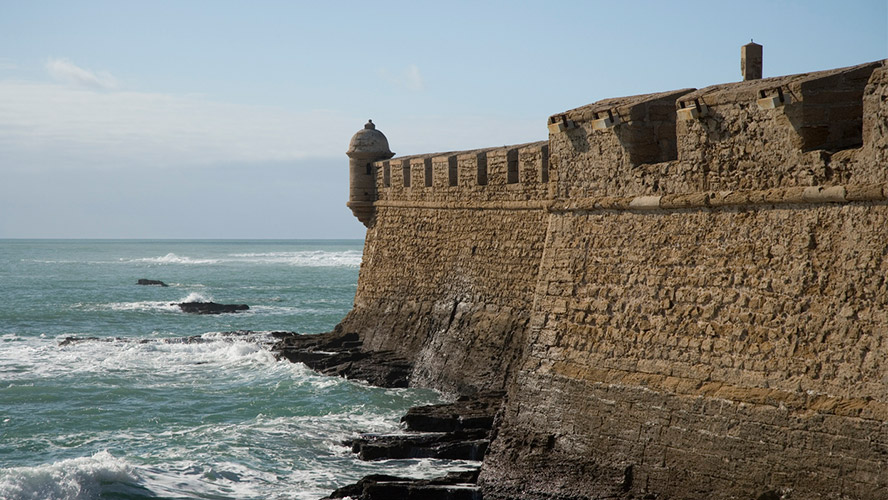

Explore the Old Town: Cádiz’s Historic Heartbeat
Winding through the narrow cobblestone streets of Cádiz’s Old Town is akin to stepping back in time. With its whitewashed buildings, ancient plazas, and a palpable sense of history, the Old Town is the soul of Cádiz, offering visitors a rich tapestry of stories, traditions, and architectural wonders.
Historical Context
Cádiz, often touted as the oldest continuously inhabited city in Western Europe, has seen a myriad of civilizations come and go, from the Phoenicians and Romans to the Moors and Christians. Each era has left its indelible mark on the Old Town, resulting in a mosaic of architectural styles, cultural influences, and historical narratives.
Architectural Gems
The Old Town is a treasure trove of architectural delights. From the grandeur of the Cádiz Cathedral and the elegance of the Baroque-style churches to the simplicity of traditional Andalusian homes with their flower-laden balconies, every corner tells a story. The city walls, remnants of Cádiz’s fortified past, encircle the Old Town, punctuated by ancient gates that once regulated entry and exit.
Don’t miss the amaizing: Exploring Malaga’s Historic Center: A Comprehensive Guide
Cultural Experiences
The plazas of the Old Town are its cultural epicenters. Places like Plaza de San Juan de Dios and Plaza de Mina come alive with cafes, street musicians, and local artisans. These squares are not just recreational spaces; they are historical landmarks where significant events have unfolded over the centuries.
Local Life
One of the joys of exploring the Old Town is witnessing the daily life of Cádiz’s residents. Traditional tapas bars, where locals gather for lively conversations over “cañas” (small beers) and “tapas,” are aplenty. The sounds of flamenco echo through the streets, a testament to the city’s deep-rooted musical traditions.
Visitor Information
- Walking Tours: To truly immerse yourself in the Old Town’s history, consider joining a guided walking tour. Knowledgeable guides weave tales of ancient legends, pirate invasions, and cultural revolutions, bringing the city’s past to life.
- Accessibility: The Old Town’s streets are pedestrian-friendly, but some areas have cobblestones, so wearing comfortable shoes is advisable. For those with mobility challenges, the flat terrain and wide plazas make navigation relatively easy.
- Local Etiquette: While the Old Town is a tourist hub, it’s also home to many locals. It’s essential to respect their privacy, especially when photographing residential areas.
Tips for a Fulfilling Exploration
- Venture off the beaten path. Some of the Old Town’s best-kept secrets are tucked away in its lesser-known alleys and courtyards.
- Sample local cuisine. The Old Town boasts some of Cádiz’s best tapas bars and restaurants, offering traditional dishes like “almejas a la marinera” (clams in sailor’s style) and “chocos con papas” (cuttlefish with potatoes).
- Visit during local festivals. Events like the Cádiz Carnival transform the Old Town into a vibrant spectacle of music, dance, and color.
Visit the Roman Theatre: Echoes of Ancient Cádiz
Tucked away in the heart of Cádiz’s Old Town lies a relic of the city’s ancient past: the Roman Theatre. As one of the largest Roman theatres in Spain, this archaeological marvel offers a glimpse into the grandeur and cultural vibrancy of Cádiz during the Roman era.
Historical Backdrop
Discovered accidentally in 1980 during construction work, the Roman Theatre dates back to the 1st century BC. Commissioned by Lucius Cornelius Balbus Minor, a close ally of Julius Caesar, the theatre was an emblem of Roman influence and power in the region. Over the centuries, as Cádiz evolved, the theatre was buried under layers of urban development, only to be unearthed and reintroduced to the world millennia later.
Architectural Grandeur
With a capacity to accommodate over 10,000 spectators, the theatre’s design is a testament to Roman architectural prowess. The semi-circular cavea (seating area) is carved out of the hillside, utilizing the natural topography for acoustics and visibility. The scaenae frons, or stage area, once adorned with statues and columns, served as the backdrop for various performances, from tragedies to comedies.
The Archaeological Site
Today, visitors can explore the remnants of the theatre, including the cavea, the orchestra pit, and parts of the stage. Informative panels and 3D reconstructions provide context, helping visitors visualize the theatre in its heyday. The adjoining interpretation center delves deeper into the theatre’s history, its significance in Roman Cádiz, and the archaeological methods employed in its restoration
Visitor Information
- Opening Hours: The Roman Theatre is open from Tuesday to Sunday, with morning and afternoon visiting slots. The timings vary based on the season, so it’s advisable to check in advance.
- Tickets: Entry to the theatre and the interpretation center is free. Guided tours, available at a nominal fee, offer a more in-depth exploration of the site.
- Location: Situated near the Cádiz Cathedral, the theatre is easily accessible on foot from various parts of the Old Town.
Tips for a Memorable Experience
- Wear comfortable footwear. The site’s uneven terrain and ancient stone steps can be challenging for some visitors.
- Consider visiting during the late afternoon. The setting sun casts a golden hue on the ruins, making for a picturesque and evocative experience.
- Engage with the on-site archaeologists and guides. Their insights and anecdotes add layers of understanding to the ruins, bringing the ancient world to life.
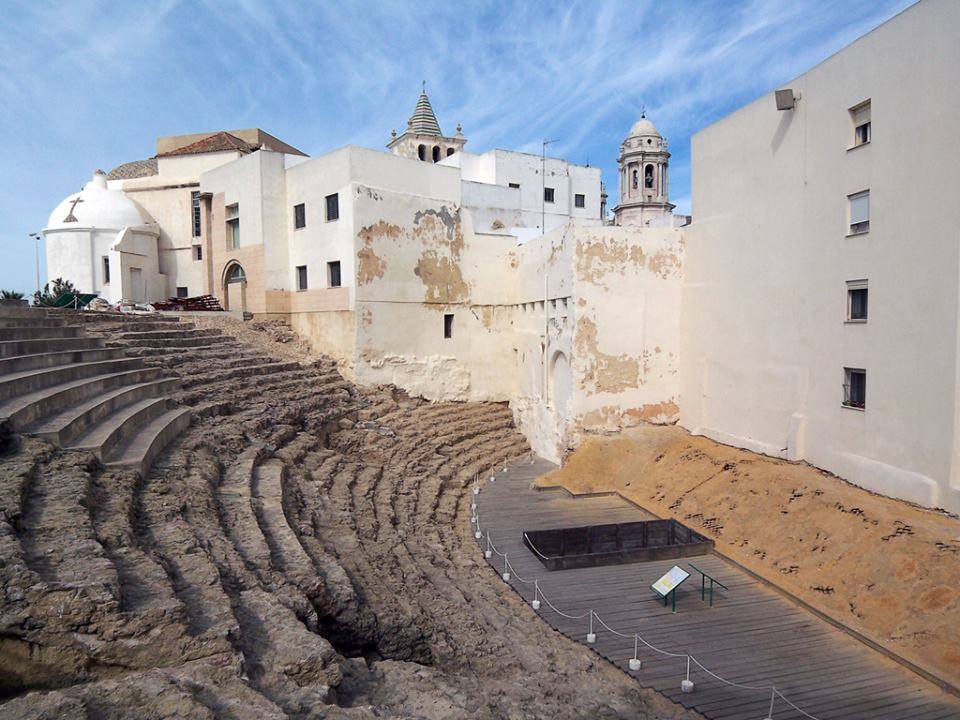

Attend the Cádiz Carnival: A Celebration of Life, Music, and Tradition
Every year, the streets of Cádiz come alive with vibrant colors, infectious rhythms, and a spirit of jubilation during the Cádiz Carnival. Recognized as one of Spain’s most significant and traditional festivals, the Cádiz Carnival is a spectacular blend of music, satire, creativity, and community participation, making it an unmissable event for both locals and visitors.
Historical Roots
The origins of the Cádiz Carnival can be traced back to the 16th century when Cádiz, due to its flourishing port, became a melting pot of diverse cultures. Influences from Italy’s Venetian Carnival, combined with Spain’s own traditions, gave birth to a unique celebration that has evolved over the centuries while retaining its core essence.
Musical Heartbeat
At the heart of the carnival lies its music. Various groups, known as “chirigotas,” “comparsas,” and “coros,” prepare for months, crafting satirical songs that comment on current events, politics, and societal trends. These performances, characterized by their wit, humor, and social critique, are a highlight of the carnival, with competitions held to honor the best groups.
Costumes and Parades
The streets become a riot of colors as participants, donned in elaborate costumes, parade through the city. From traditional flamenco dresses to satirical representations of public figures, the creativity on display is boundless. The “Carrusel de Coros” is a particularly enchanting event, where groups sing atop beautifully decorated horse-drawn carriages.
La Gran Cabalgata
One of the carnival’s pinnacle events is the Grand Parade, where floats, dancers, musicians, and performers come together in a grand spectacle. The parade culminates in the crowning of the Carnival Queen and her court, a moment of great anticipation and celebration.
Visitor Information
- Dates: The Cádiz Carnival typically takes place in February or March, depending on the date of Easter. It lasts for ten days, culminating on the weekend before Ash Wednesday.
- Tickets: While many of the street performances and parades are free, some of the musical competitions and events held in theaters may require tickets. It’s advisable to book in advance, especially for popular shows.
- Location: The entire city of Cádiz becomes the carnival’s stage, with events, performances, and parades taking place in various squares, streets, and theaters.
Tips for a Memorable Experience
- Dress up! Embrace the carnival spirit by donning a costume or mask. It’s a fun way to immerse yourself in the festivities.
- Sample traditional carnival foods. Look out for “pestiños” (honey-coated pastries) and “tortillitas de camarones” (shrimp fritters).
- Plan your itinerary. With so much happening simultaneously, it’s helpful to have a rough schedule of the events and performances you want to attend.
Take a Boat Tour: Navigating the Waters of Cádiz
Cádiz, often referred to as the “Silver Cup” due to its strategic location on a narrow peninsula, boasts a rich maritime heritage that has shaped its history, culture, and economy. One of the best ways to truly appreciate the city’s coastal beauty and understand its maritime significance is by embarking on a boat tour, offering a unique perspective of Cádiz from its surrounding waters.
Historical Perspective
Cádiz’s harbor has been a hub of activity for millennia, with Phoenicians, Romans, Moors, and Spaniards all navigating its waters. A boat tour provides a vantage point to view the city’s ancient fortifications, historic buildings, and modern port facilities, all while listening to tales of naval battles, trade routes, and explorers who set sail from this very coast.
Types of Tours
- Harbor Cruises: These tours offer a leisurely cruise around Cádiz’s harbor, providing panoramic views of the city skyline, beaches, and fortresses. Commentary often delves into the city’s maritime history and its significance in global trade.
- Sunset Cruises: Experience the magic of a Cádiz sunset from the water. As the sun dips below the horizon, the city is bathed in a golden hue, creating a romantic and serene ambiance. These tours often include live music and refreshments.
- Whale and Dolphin Watching: Venture further into the Strait of Gibraltar, where the Atlantic meets the Mediterranean. This area is rich in marine life, and with a bit of luck, you might spot pods of dolphins, orcas, and even the occasional whale.
Enjoy the Sea? : Sailing Through History: The Tourist Boat Ride in Malaga
Visitor Information
- Duration: Tours can range from short one-hour harbor cruises to longer half-day excursions, especially for wildlife watching.
- Tickets: It’s advisable to book in advance, especially during peak tourist season. Some operators offer online booking, while others have kiosks along the harbor.
- Departure Points: Most tours depart from Cádiz’s main port area, easily accessible from the city center. Ensure you arrive a bit early for boarding and safety briefings.
Tips for a Memorable Journey
- Dress appropriately. Even on warm days, it can get chilly on the water, especially in the evenings. Carrying a light jacket or windbreaker is a good idea.
- Don’t forget your camera! Whether it’s capturing the city’s silhouette, a playful dolphin, or a mesmerizing sunset, there are ample photo opportunities.
- Engage with the crew. They often have a wealth of knowledge about the local waters, marine life, and Cádiz’s maritime history.
Sample Local Cuisine: A Culinary Journey Through Cádiz
Cádiz, with its rich maritime heritage and Andalusian roots, boasts a culinary landscape that is as diverse as its history. The city’s gastronomy is a delightful blend of land and sea, offering flavors that are both robust and subtle, traditional and innovative. For those keen on immersing themselves in the local culture, sampling Cádiz’s cuisine is an experience not to be missed.
Seafood Delights
Given its coastal location, it’s no surprise that seafood is a staple in Cádiz. The city’s eateries offer a plethora of marine delicacies:
- Pescaíto Frito: A mixed fry of fish, often including species like dogfish, anchovies, and squid. Lightly battered and deep-fried, it’s a must-try.
- Almejas a la Marinera: Clams cooked in a savory sauce made of garlic, onion, parsley, and white wine.
- Tortillitas de Camarones: Thin, crispy fritters made with tiny shrimp, flour, onions, and parsley.
More seafood delights: Grill Fish of Malaga: All you need to now about Espetos
Land Meets Sea
Cádiz’s cuisine also showcases dishes that beautifully meld ingredients from the land and the sea:
- Flamenquín Gaditano: A variation of the Andalusian classic, this dish features fish wrapped in ham, breaded, and fried to perfection.
- Choco con Papas: A hearty stew made with cuttlefish and potatoes, seasoned with garlic, onion, and peppers.


Meats and More
While seafood dominates, Cádiz also offers a range of meat-based dishes:
- Carrillada: Tender pork or beef cheeks slow-cooked in a rich sauce until they’re melt-in-the-mouth soft.
- Chicharrones Especiales: Thin slices of seasoned pork belly, fried until crispy.
Sweet Endings
No culinary journey is complete without desserts, and Cádiz doesn’t disappoint:
- Tocino de Cielo: A creamy, custard-like dessert made with egg yolks and sugar, often topped with a caramel glaze.
- Pestiños: Deep-fried pastries, usually flavored with anise and coated in honey.
Local Wines
Cádiz is renowned for its wines, especially the sherries from the nearby Jerez region. From the dry and crisp Fino to the sweet and rich Pedro Ximénez, there’s a sherry for every palate.
Don’t miss our blog about: The Top 8 Spanish Wine Regions and a Brief History of Spanish Wine
Visitor Information
- Tapas Culture: Many eateries in Cádiz follow the tapas culture, offering small portions of dishes. This allows diners to sample a variety of flavors in one meal.
- Local Markets: For a truly authentic experience, visit markets like Mercado Central de Abastos. Here, you can savor fresh produce and even enjoy cooked meals at various stalls.
- Dining Etiquette: Lunch, usually between 2 PM and 4 PM, is the main meal. Dinner is lighter and is typically served post 8 PM.
Tips for a Gastronomic Adventure
- Always ask locals for recommendations. They often know hidden gems that offer the most authentic and delicious dishes.
- Pair your meals with local wines. The staff at eateries can suggest the best wine-food combinations.
- Don’t shy away from trying something new. Cádiz’s cuisine is full of surprises, and you might discover a new favorite dish.
Cádiz Beyond the City: Discovering the Wider Province
While the city of Cádiz, with its rich history and vibrant culture, is undoubtedly a gem, the broader province of Cádiz offers a plethora of experiences that are equally enchanting. From pristine beaches and natural parks to quaint villages and archaeological sites, venturing beyond the city limits promises a diverse array of adventures that capture the essence of Andalusia.
1. White Villages of Cádiz
The province is renowned for its “Pueblos Blancos” or White Villages – a series of towns characterized by whitewashed buildings, red-tiled roofs, and narrow cobblestone streets.
- Arcos de la Frontera: Perched on a cliff, this town offers panoramic views of the Guadalete River valley. Its Gothic cathedral, Moorish castle, and charming plazas are a testament to its rich history.
- Grazalema: Within the Sierra de Grazalema Natural Park, this village is known for its traditional crafts, especially woolen goods, and its unique microclimate, which results in lush vegetation.
2. Natural Wonders
The province’s diverse landscapes, from mountains to marshlands, are a haven for nature enthusiasts.
- Doñana National Park: A UNESCO World Heritage site, this park is a mosaic of ecosystems, providing sanctuary to a variety of wildlife, including the Iberian lynx and flamingos.
- Sierra de Grazalema Natural Park: A paradise for hikers, this park boasts limestone caves, deep gorges, and the Pinsapar forest, home to the rare Spanish fir.
3. Coastal Escapes
Beyond the city’s beaches, the Cádiz coastline offers secluded coves, dramatic cliffs, and charming coastal towns.
- Bolonia: Known for its pristine beach and the ancient Roman city of Baelo Claudia, Bolonia is a blend of natural beauty and history.
- Zahara de los Atunes: A fishing village turned trendy beach destination, Zahara is famed for its fresh tuna and vibrant nightlife.
4. Gastronomic Adventures
The province’s culinary landscape is as diverse as its geography.
- Jerez de la Frontera: The birthplace of sherry, this town offers winery tours where you can learn about the intricate process of making this iconic wine and indulge in tastings.
- Sanlúcar de Barrameda: Renowned for its Manzanilla wine and seafood, especially the langostinos (king prawns), a visit here is a treat for the palate.
5. Cultural Festivities
The province’s towns and villages host a range of festivals that showcase local traditions.
- Horse Fair in Jerez: A week-long celebration of the region’s equestrian heritage, featuring horse parades, flamenco performances, and traditional Andalusian food.
- Carnival of La Viña: While Cádiz city hosts the main carnival, the La Viña neighborhood has its own unique celebrations, marked by satirical songs, colorful costumes, and a vibrant community spirit.
Tips for Exploring Cádiz Province
- Renting a car can be beneficial, allowing you the flexibility to explore the province at your own pace.
- While Spanish is the primary language, the warmth of the locals makes it easy to communicate, even with a language barrier.
- Always check the local calendar for festivals and events. Participating in these can offer a deeper understanding of the region’s culture.
Cádiz, often referred to as the ‘Silver Cup’ of Spain, is a city that effortlessly blends its ancient roots with the vibrancy of the present. Its allure lies not just in its historical landmarks or pristine beaches, but in the spirit of its people, the caditanos, who carry forward the legacy of their ancestors with pride and warmth. As the sun sets over the Atlantic, casting a golden hue over the city, one can’t help but be captivated by the timeless charm of Cádiz. Whether you’re a history enthusiast, a beach lover, or simply a traveler seeking soulful experiences, Cádiz promises memories that will linger long after you’ve left its shores.
